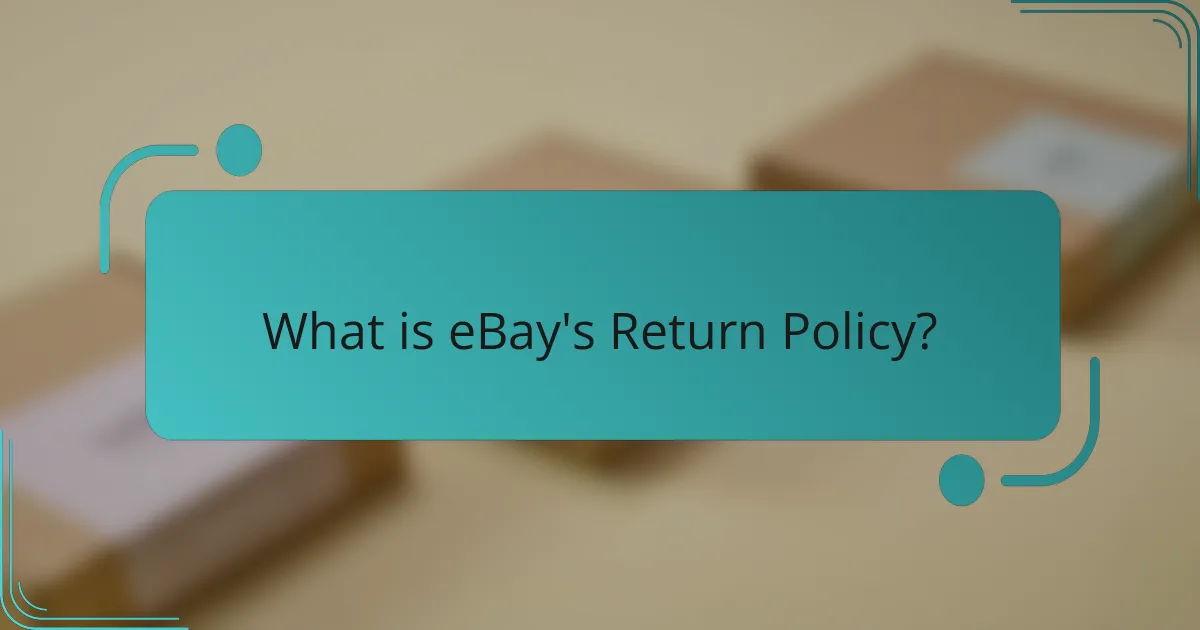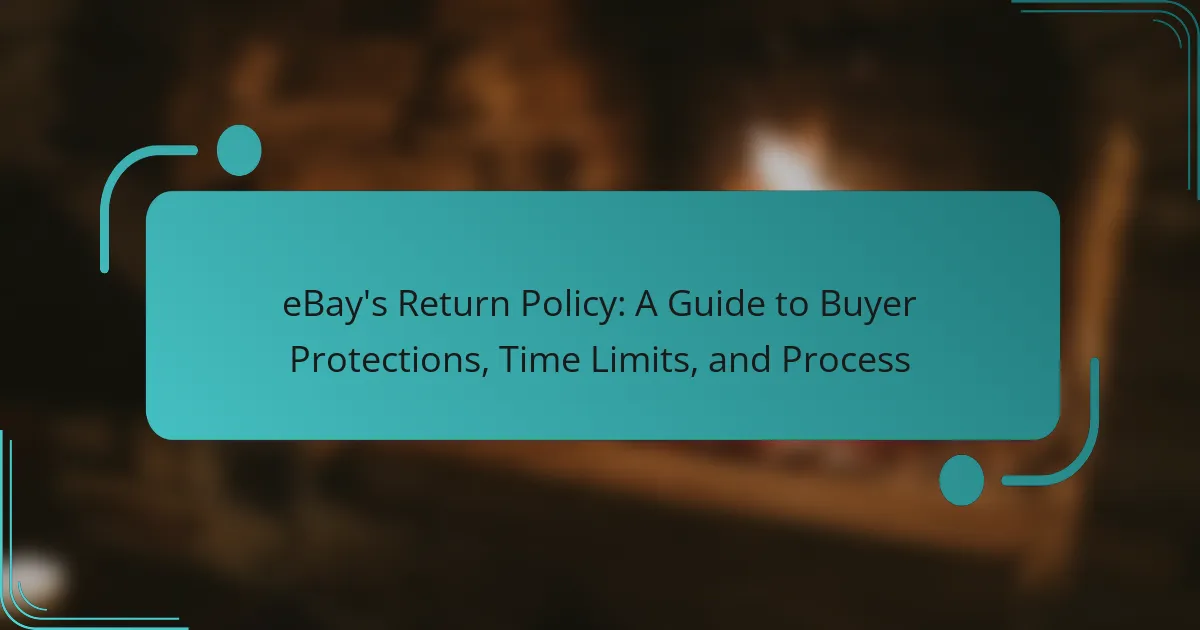
What is eBay’s Return Policy?
eBay’s Return Policy allows buyers to return items within a specified timeframe. The standard return period is 30 days from the date of delivery. Sellers can choose their own return policies, which may vary. Most sellers accept returns for any reason, while some may only accept returns for specific issues. Buyers are responsible for return shipping unless the seller specifies otherwise. Refunds are typically processed within a few days after the seller receives the returned item. eBay also offers a money-back guarantee for eligible transactions. This policy aims to enhance buyer confidence and satisfaction.
How does eBay’s Return Policy protect buyers?
eBay’s Return Policy protects buyers by allowing them to return items that do not match the seller’s description. This policy ensures that buyers receive products as advertised. If an item is defective or not as described, buyers can initiate a return within a specified timeframe. eBay typically provides a 30-day return window for most items. Buyers are also protected by eBay’s Money Back Guarantee. This guarantee covers the purchase price and original shipping costs if the item is not received or is significantly different from the listing. Additionally, eBay encourages sellers to offer hassle-free returns, which enhances buyer confidence. Overall, these measures create a safer shopping environment for eBay users.
What are the key features of eBay’s buyer protection?
eBay’s buyer protection includes several key features. It ensures refunds for eligible purchases if items are not received. Buyers are also protected against items that do not match the description. The program covers most transactions, providing peace of mind. eBay guarantees that buyers can return items within a specified time frame. This feature enhances buyer confidence in their purchases. Additionally, eBay’s customer support assists in resolving disputes. The protection is backed by eBay’s policies, which are designed to foster trust.
How does eBay ensure seller accountability?
eBay ensures seller accountability through a combination of feedback systems and policies. Sellers are required to maintain a minimum performance standard. This includes metrics such as shipping time and item as described ratings. eBay monitors these metrics closely. If sellers fail to meet these standards, they may face penalties. These penalties can include restrictions on selling privileges or account suspension. Additionally, eBay encourages buyers to leave feedback after transactions. This feedback influences seller ratings and visibility. High ratings can lead to increased sales opportunities for sellers. Thus, eBay’s structured approach promotes accountability among its sellers.
What are the time limits associated with eBay’s Return Policy?
eBay’s Return Policy typically allows buyers to initiate a return within 30 days of receiving an item. Some sellers may offer extended return periods, up to 60 days. The return request must be submitted through eBay’s platform. Once a return is initiated, the seller has a specified timeframe to provide a return shipping label. Buyers should return items in their original condition to ensure a full refund. eBay’s policy ensures that buyers are protected during the return process.
What is the standard return window for most items?
The standard return window for most items on eBay is 30 days. This period allows buyers to return items for a full refund if they are not satisfied. Some sellers may offer longer return windows, but 30 days is the most common timeframe. eBay’s policy ensures that buyers have ample time to evaluate their purchases. This return policy applies to both new and used items sold on the platform. Buyers should check individual listings for specific return terms.
How do time limits vary for different categories of products?
Time limits for returns on eBay vary by product category. Generally, most items must be returned within 30 days. However, electronics may have a longer return window of up to 60 days. Some categories, such as clothing, often adhere to the standard 30-day return policy. Certain sellers may offer extended return periods, which can reach up to 90 days. Additionally, items marked as “for parts or not working” may not be eligible for returns at all. This variability is designed to accommodate the specific needs and expectations of different product types.
What is the process for returning an item on eBay?
To return an item on eBay, start by locating the item in your purchase history. Click on the “Return this item” option next to the item. Follow the prompts to select a reason for the return. Print the return shipping label provided by eBay. Package the item securely and attach the shipping label. Ship the item back to the seller within the specified return window. Once the seller receives the item, they will process your refund. eBay’s return policy allows returns within 30 days for most items.
How do buyers initiate a return request?
Buyers initiate a return request by accessing their eBay account. They navigate to the “Purchase History” section. In this section, they find the item they wish to return. Buyers select the item and click on the “Return this item” option. They then follow the prompts to specify the reason for the return. After completing the form, buyers submit the request. eBay typically processes the return request quickly. This process ensures that buyers can return items according to eBay’s return policy.
What steps do sellers need to follow once a return is requested?
Sellers must first acknowledge the return request through the eBay platform. They should then review the return reason provided by the buyer. Next, sellers need to provide return shipping instructions to the buyer. After that, they must wait for the returned item to be received. Once the item is received, sellers should inspect it for condition and completeness. Finally, they must process the refund or exchange as per eBay’s guidelines. Following these steps ensures compliance with eBay’s return policy and protects seller ratings.
How does eBay’s Return Policy handle disputes?
eBay’s Return Policy addresses disputes through a structured resolution process. When a buyer initiates a return, eBay encourages communication between the buyer and seller. If a disagreement arises, eBay provides a resolution center for mediation. The policy outlines specific timelines for responses from both parties. Buyers are protected under the Money Back Guarantee if items are not as described. Sellers must adhere to eBay’s guidelines for returns to avoid disputes. eBay monitors cases and may intervene if necessary. This structured approach helps ensure fair outcomes for both buyers and sellers.
What options do buyers have if a return is denied?
Buyers have several options if a return is denied. They can contact the seller directly to discuss the issue. Communication may lead to a resolution or an alternative solution. Buyers can also review eBay’s return policy for specific guidelines on their case. If the seller remains unresponsive, buyers can escalate the issue to eBay’s customer support. eBay provides a resolution center for disputes. Filing a claim through this center allows buyers to seek assistance. Additionally, buyers can leave feedback for the seller. This feedback can impact the seller’s reputation on the platform. Each of these steps can help buyers navigate a denied return effectively.
How can buyers escalate issues with eBay’s customer service?
Buyers can escalate issues with eBay’s customer service by contacting eBay directly through their Help & Contact page. They can select the relevant issue and follow the prompts to reach a customer service representative. If the initial contact does not resolve the issue, buyers can request to speak with a supervisor. eBay also provides a contact option through their mobile app, allowing users to escalate issues conveniently. Additionally, buyers can use social media channels like Twitter for prompt assistance. This escalation process is designed to ensure that unresolved issues receive further attention from higher-level support.
What are some common tips for navigating eBay’s Return Policy?
To navigate eBay’s Return Policy effectively, first understand the specific return window for your item. Most items have a return period of 30 days from delivery. Always check the seller’s return policy details on the listing page. This information outlines whether returns are accepted and any conditions that apply. Use eBay’s return process to initiate a return. This ensures your return is documented and tracked. Keep all original packaging and receipts until the return is complete. This can help resolve any disputes. Communicate with the seller if issues arise during the return process. eBay encourages direct communication to facilitate resolutions. Lastly, familiarize yourself with eBay’s Money Back Guarantee. This provides additional protection for eligible returns.
How can buyers ensure a smooth return process?
Buyers can ensure a smooth return process by following eBay’s return policy guidelines. First, they should review the seller’s return policy before making a purchase. This includes checking the return window and any specific conditions. Next, buyers should keep the original packaging and receipt, as these may be required for the return.
Additionally, initiating the return request through the eBay platform is essential. This allows for tracking and documentation of the return process. Buyers must also ship the item back using a reliable method, ensuring it is well-protected during transit.
Lastly, communicating with the seller can help resolve any issues that arise during the return. According to eBay’s policies, adhering to these steps can facilitate a hassle-free return experience.
What should buyers keep in mind when purchasing items with a return option?
Buyers should verify the return policy details before purchasing items with a return option. This includes understanding the time frame for returns, which is typically 30 days on eBay. Buyers must check if the item is eligible for a full refund or if restocking fees apply. It’s important to know whether return shipping costs are covered by the seller or the buyer. Buyers should also inspect the condition of the item upon arrival to ensure it matches the listing description. Reading seller reviews can provide insights into their reliability regarding returns. Finally, buyers should retain all packaging and documentation until they are certain they want to keep the item.
eBay’s Return Policy is designed to provide buyers with protections and a clear process for returning items. The standard return period is 30 days, during which buyers can return items that do not match the seller’s description or are defective. Sellers have the flexibility to set their own return policies, which may vary, but eBay’s Money Back Guarantee enhances buyer confidence by ensuring refunds for eligible transactions. The article outlines the steps for initiating returns, the time limits associated with different product categories, and tips for navigating the return process effectively. Additionally, it discusses how eBay promotes seller accountability and handles disputes to foster a secure shopping environment.
